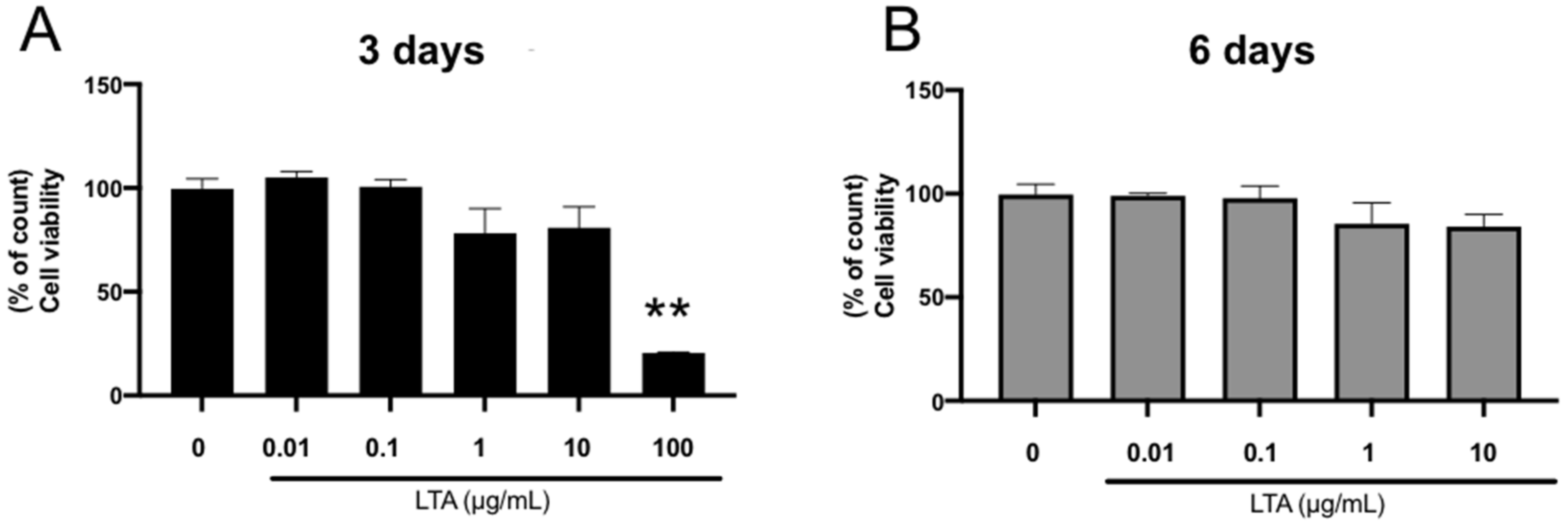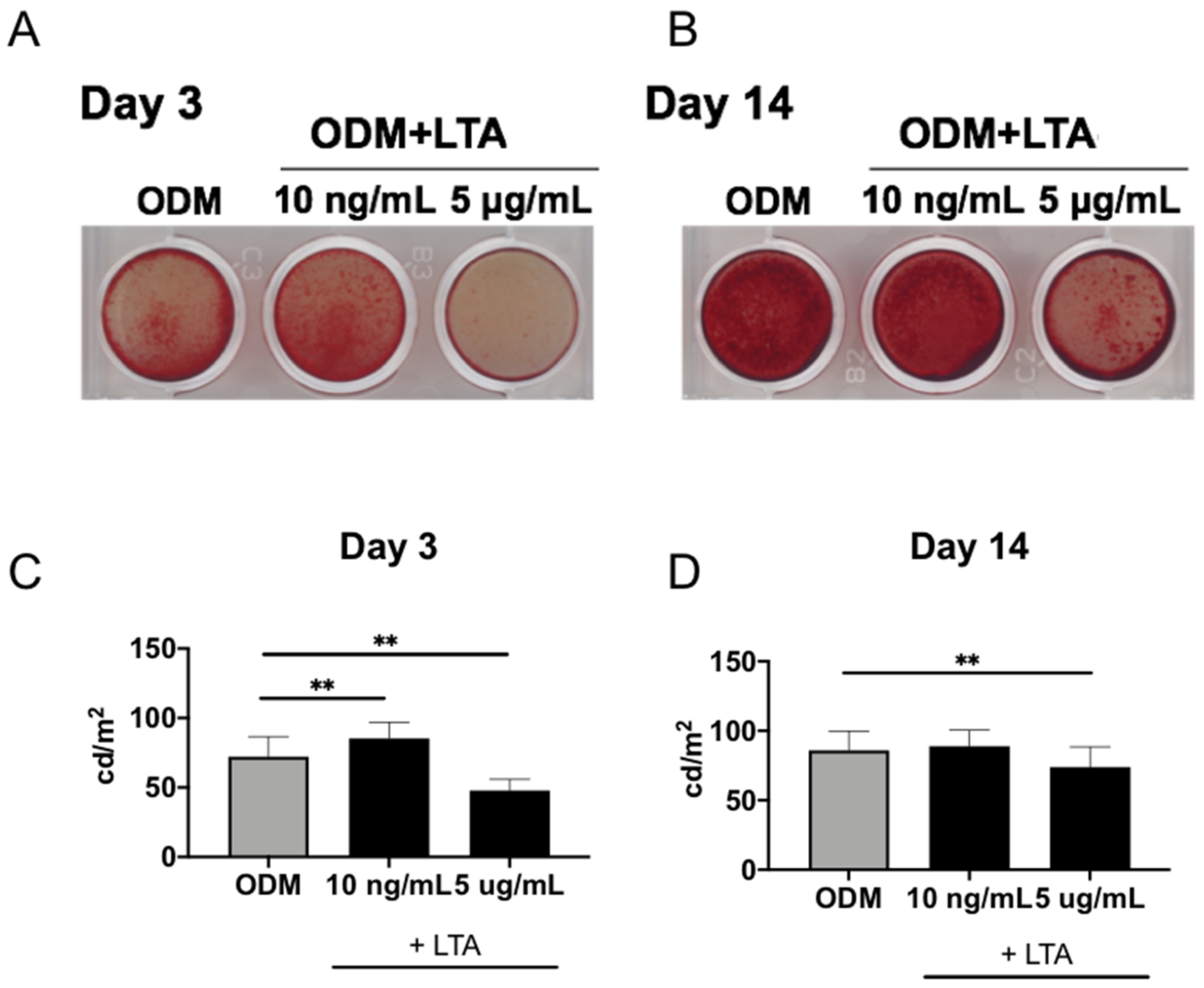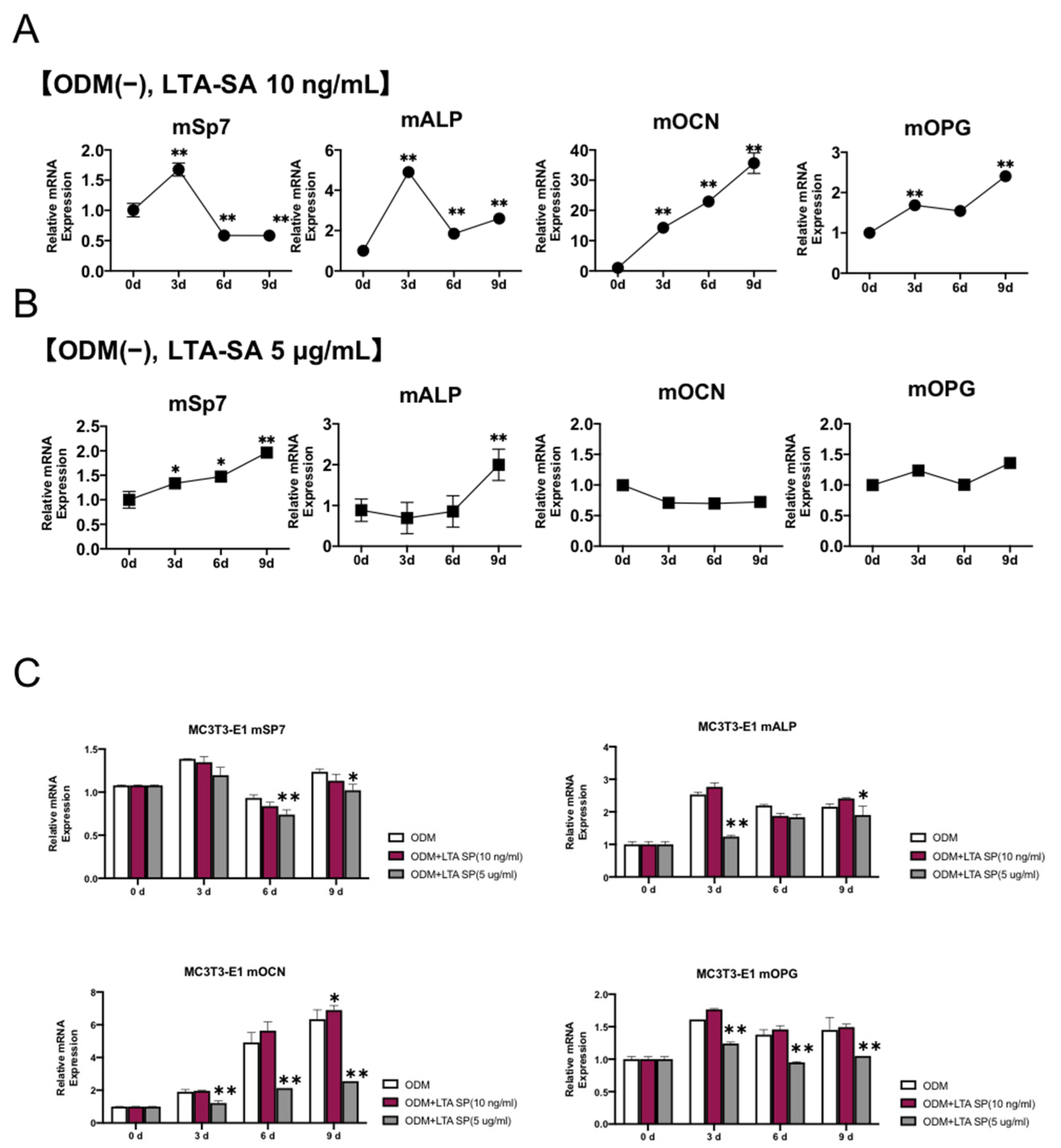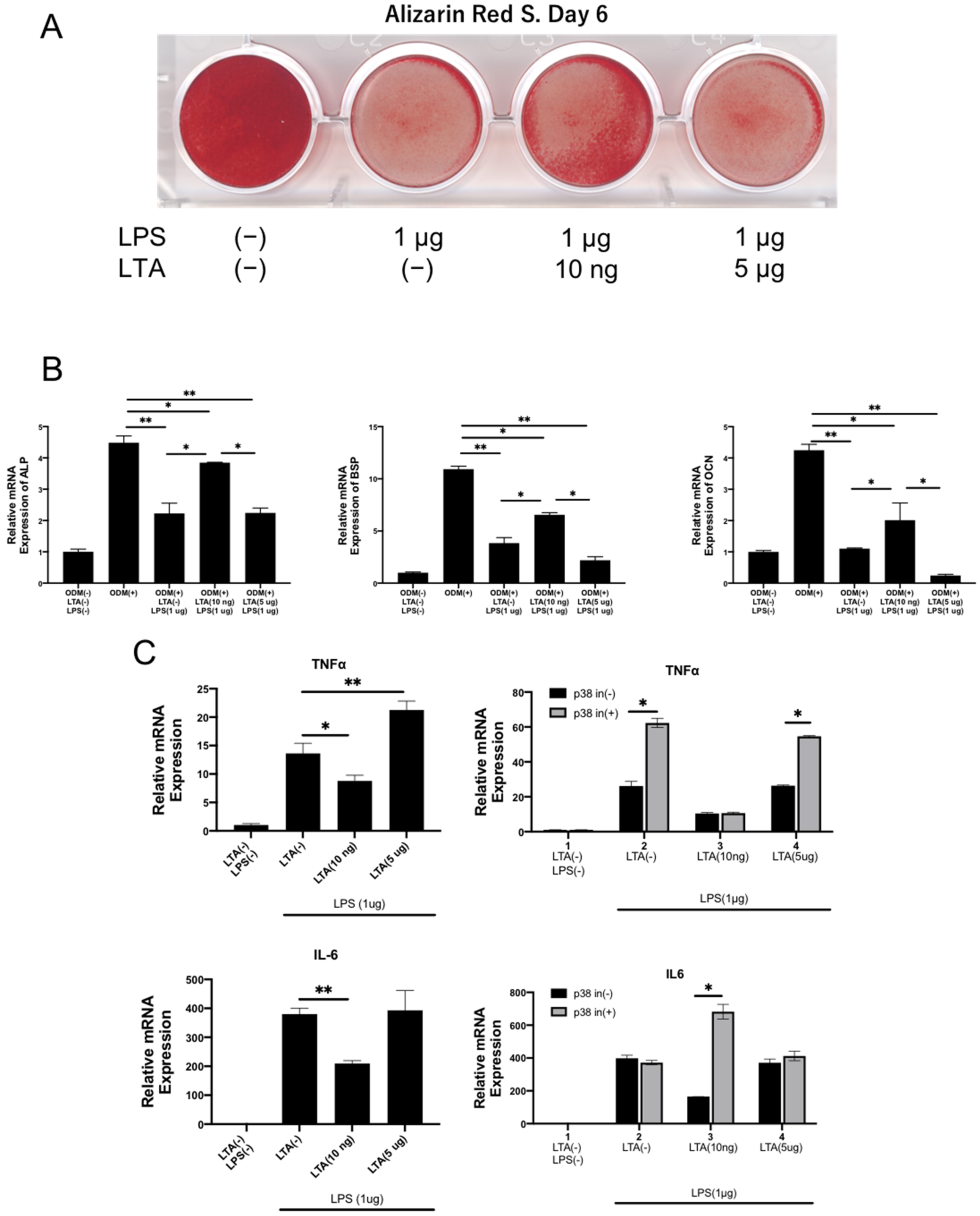Lipoteichoic Acid and Lipopolysaccharides Are Affected by p38 and Inflammatory Markers and Modulate Their Promoting and Inhibitory Effects on Osteogenic Differentiation
Abstract
1. Introduction
2. Results
2.1. Effect of LTA on the Viability of Mouse Embryonic Osteoblast Precursor Cells
2.2. Effects of LTA on the Formation of Mineralized Nodules
2.3. Effects of LTA on the Expression of Osteogenic-Related Factors
2.4. Relationship between Low-Concentration LTA and High-Concentration LPS on Bone Differentiation, Inflammatory Markers, and p38
3. Discussion
4. Materials and Methods
4.1. Cell Culture and Osteogenic Differentiation
4.2. Antibodies and Reagents
4.3. MTS Assay
4.4. Alizarin Red Staining
4.5. Real-Time Reverse Transcription PCR Analysis
4.6. Statistical Analysis
Author Contributions
Funding
Institutional Review Board Statement
Informed Consent Statement
Data Availability Statement
Conflicts of Interest
References
- Khemaleelakul, S.; Baumgartner, J.C.; Pruksakorn, S. Identification of Bacteria in Acute Endodontic Infections and Their Antimicrobial Susceptibility. Oral Surg. Oral Med. Oral Pathol. Oral Radiol. Endodontology 2002, 94, 746–755. [Google Scholar] [CrossRef] [PubMed]
- Peng, X.; Cheng, L.; You, Y.; Tang, C.; Ren, B.; Li, Y.; Xu, X.; Zhou, X. Oral Microbiota in Human Systematic Diseases. Int. J. Oral Sci. 2022, 14, 14. [Google Scholar] [CrossRef] [PubMed]
- Hudson, J.W. Osteomyelitis of the Jaws: A 50-Year Perspective. J. Oral Maxillofac. Surg. 1993, 51, 1294–1301. [Google Scholar] [CrossRef]
- Haeffs, T.H.; Scott, C.A.; Campbell, T.H.; Chen, Y.; August, M. Acute and Chronic Suppurative Osteomyelitis of the Jaws: A 10-Year Review and Assessment of Treatment Outcome. J. Oral Maxillofac. Surg. 2018, 76, 2551–2558. [Google Scholar] [CrossRef] [PubMed]
- Reid, I.R. Osteonecrosis of the Jaw—Who Gets It, and Why? Bone 2009, 44, 4–10. [Google Scholar] [CrossRef] [PubMed]
- Ogawa, A.; Miyate, H.; Nakamura, Y.; Shimada, M.; Seki, S.; Kudo, K. Treating Chronic Diffuse Sclerosing Osteomyelitis of the Mandible with Saucerization and Autogenous Bone Grafting. Oral Surg. Oral Med. Oral Pathol. Oral Radiol. Endodontology 2001, 91, 390–394. [Google Scholar] [CrossRef] [PubMed]
- Neuhaus, F.C.; Baddiley, J. A Continuum of Anionic Charge: Structures and Functions of d -Alanyl-Teichoic Acids in Gram-Positive Bacteria. Microbiol. Mol. Biol. Rev. 2003, 67, 686–723. [Google Scholar] [CrossRef]
- Wang, S.; Chin Heng, B.; Qiu, S.; Deng, J.; Shun Pan Cheung, G.; Jin, L.; Zhao, B.; Zhang, C. Lipoteichoic Acid of Enterococcus Faecalis Inhibits Osteoclastogenesis via Transcription Factor RBP-J. Innate Immun. 2019, 25, 13–21. [Google Scholar] [CrossRef]
- Yin, W.; Liu, S.; Dong, M.; Liu, Q.; Shi, C.; Bai, H.; Wang, Q.; Yang, X.; Niu, W.; Wang, L. A New NLRP3 Inflammasome Inhibitor, Dioscin, Promotes Osteogenesis. Small 2020, 16, 1905977. [Google Scholar] [CrossRef]
- Shayegan, A.; Zucchi, A.; de Swert, K.; Balau, B.; Truyens, C.; Nicaise, C. Lipoteichoic Acid Stimulates the Proliferation, Migration and Cytokine Production of Adult Dental Pulp Stem Cells without Affecting Osteogenic Differentiation. Int. Endod. J. 2021, 54, 585–600. [Google Scholar] [CrossRef]
- Hu, C.C.; Chang, C.H.; Hsiao, Y.M.; Chang, Y.; Wu, Y.Y.; Ueng, S.W.N.; Chen, M.F. Lipoteichoic Acid Accelerates Bone Healing by Enhancing Osteoblast Differentiation and Inhibiting Osteoclast Activation in a Mouse Model of Femoral Defects. Int. J. Mol. Sci. 2020, 21, 5550. [Google Scholar] [CrossRef]
- Bandow, K.; Maeda, A.; Kakimoto, K.; Kusuyama, J.; Shamoto, M.; Ohnishi, T.; Matsuguchi, T. Molecular Mechanisms of the Inhibitory Effect of Lipopolysaccharide (LPS) on Osteoblast Differentiation. Biochem. Biophys. Res. Commun. 2010, 402, 755–761. [Google Scholar] [CrossRef]
- Xing, Q.; Ye, Q.; Fan, M.; Zhou, Y.; Xu, Q.; Sandham, A. Porphyromonas Gingivalis Lipopolysaccharide Inhibits the Osteoblastic Differentiation of Preosteoblasts by Activating Notch1 Signaling. J. Cell Physiol. 2010, 225, 106–114. [Google Scholar] [CrossRef]
- Herath, T.D.K.; Wang, Y.; Seneviratne, C.J.; Lu, Q.; Darveau, R.P.; Wang, C.Y.; Jin, L. Porphyromonas Gingivalis Lipopolysaccharide Lipid A Heterogeneity Differentially Modulates the Expression of IL-6 and IL-8 in Human Gingival Fibroblasts. J. Clin. Periodontol. 2011, 38, 694–701. [Google Scholar] [CrossRef]
- Yu, X.; Quan, J.; Long, W.; Chen, H.; Wang, R.; Guo, J.; Lin, X.; Mai, S. LL-37 Inhibits LPS-Induced Inflammation and Stimulates the Osteogenic Differentiation of BMSCs via P2X7 Receptor and MAPK Signaling Pathway. Exp. Cell Res. 2018, 372, 178–187. [Google Scholar] [CrossRef]
- Mo, I.F.Y.; Yip, K.H.K.; Chan, W.K.; Law, H.K.W.; Lau, Y.L.; Chan, G.C.F. Prolonged Exposure to Bacterial Toxins Downregulated Expression of Toll-like Receptors in Mesenchymal Stromal Cell-Derived Osteoprogenitors. BMC Cell Biol. 2008, 9, 52. [Google Scholar] [CrossRef]
- Zhang, Y.; Gu, X.; Li, D.; Cai, L.; Xu, Q. Mettl3 Regulates Osteoblast Differentiation and Inflammatory Response via Smad Signaling and Mapk Signaling. Int. J. Mol. Sci. 2020, 21, 199. [Google Scholar] [CrossRef]
- Rodríguez-Carballo, E.; Gámez, B.; Ventura, F. P38 MAPK Signaling in Osteoblast Differentiation. Front. Cell Dev. Biol. 2016, 4, 40. [Google Scholar] [CrossRef]
- Croes, M.; Kruyt, M.C.; Loozen, L.; Kragten, A.H.M.; Yuan, H.; Dhert, W.J.; Öner, F.C.; Alblas, J. Local Induction of Inflammation Affects Bone Formation. Eur. Cell Mater. 2017, 33, 211–226. [Google Scholar] [CrossRef]
- Liu, X.; Wang, Y.; Cao, Z.; Dou, C.; Bai, Y.; Liu, C.; Dong, S.; Fei, J. Staphylococcal Lipoteichoic Acid Promotes Osteogenic Differentiation of Mouse Mesenchymal Stem Cells by Increasing Autophagic Activity. Biochem. Biophys. Res. Commun. 2017, 485, 421–426. [Google Scholar] [CrossRef]
- Valenza, F.; Fagnani, L.; Coppola, S.; Froio, S.; Sacconi, F.; Tedesco, C.; Maffioletti, M.; Pizzocri, M.; Salice, V.; Ranzi, M.L.; et al. Prevalence of Endotoxemia after Surgery and Its Association with ICU Length of Stay. Crit. Care 2009, 13, R102. [Google Scholar] [CrossRef]
- Suda, K.; Woo, J.T.; Takami, M.; Sexton, P.M.; Nagai, K. Lipopolysaccharide Supports Survival and Fusion of Preosteoclasts Independent of TNF-α, IL-1, and RANKL. J. Cell Physiol. 2002, 190, 101–108. [Google Scholar] [CrossRef]
- Kim, H.A.; Cho, M.L.; Choi, H.Y.; Yoon, C.S.; Jhun, J.Y.; Oh, H.J.; Kim, H.Y. The Catabolic Pathway Mediated by Toll-like Receptors in Human Osteoarthritic Chondrocytes. Arthritis Rheum. 2006, 54, 2152–2163. [Google Scholar] [CrossRef]
- Kondo, A.; Mogi, M.; Koshihara, Y.; Togari, A. Signal Transduction System for Interleukin-6 and Interleukin-11 Synthesis Stimulated by Epinephrine in Human Osteoblasts and Human Osteogenic Sarcoma Cells. Biochem. Pharmacol. 2001, 61, 319–326. [Google Scholar] [CrossRef]
- Ebert, R.; Benisch, P.; Krug, M.; Zeck, S.; Meißner-Weigl, J.; Steinert, A.; Rauner, M.; Hofbauer, L.; Jakob, F. Acute Phase Serum Amyloid A Induces Proinflammatory Cytokines and Mineralization via Toll-like Receptor 4 in Mesenchymal Stem Cells. Stem Cell Res. 2015, 15, 231–239. [Google Scholar] [CrossRef]
- Li, X.; Liu, C.; Li, Y.; Xiong, W.; Zuo, D. Inflammation Promotes Erythropoietin Induced Vascular Calcification by Activating P38 Pathway. Bioengineered 2022, 13, 5277–5291. [Google Scholar] [CrossRef]




| Gene | Primer Sequence [5′-3′] | Product Size | |
|---|---|---|---|
| Rpl13a | Forward | GCTTACCTGGGGCGTCTG | 149 bp |
| Reverse | ACATTCTTTTCTGCCTGTTTCC | ||
| TNF-α | Forward | TCCCCAAAGGGATGAGAAGTT | 345 bp |
| Reverse | GAGGAGGTTGACTTTCTCCTGG | ||
| IL-6 | Forward | CAACGATGATGCACTTGCAGA | 142 bp |
| Reverse | CTCCAGGTAGCTATGGTACTCCAGA | ||
| Sp7 | Forward | TATGCTCCGACCTCCTCAAC | 120 bp |
| Reverse | AATAGGATTGGGAAGCAGAAAG | ||
| Alp | Forward | GGCTTCTTCTTGCTGGTGGAA | 97 bp |
| Reverse | CCTGGTCCATCTCCACTGCT | ||
| Bsp | Forward | AGGGAACTGACCAGTGTTGG | 124 bp |
| Reverse | ACTCAACGGTGCTGCTTTTT | ||
| Ocn | Forward | CTCACAGATGCCAAGCCCA | 98 bp |
| Reverse | CCAAGGTAGCGCCGGAGTCT | ||
Publisher’s Note: MDPI stays neutral with regard to jurisdictional claims in published maps and institutional affiliations. |
© 2022 by the authors. Licensee MDPI, Basel, Switzerland. This article is an open access article distributed under the terms and conditions of the Creative Commons Attribution (CC BY) license (https://creativecommons.org/licenses/by/4.0/).
Share and Cite
Ishihata, K.; Seong, C.-H.; Kibe, T.; Nakazono, K.; Mardiyantoro, F.; Tada, R.; Nishimura, M.; Matsuguchi, T.; Nakamura, N. Lipoteichoic Acid and Lipopolysaccharides Are Affected by p38 and Inflammatory Markers and Modulate Their Promoting and Inhibitory Effects on Osteogenic Differentiation. Int. J. Mol. Sci. 2022, 23, 12633. https://doi.org/10.3390/ijms232012633
Ishihata K, Seong C-H, Kibe T, Nakazono K, Mardiyantoro F, Tada R, Nishimura M, Matsuguchi T, Nakamura N. Lipoteichoic Acid and Lipopolysaccharides Are Affected by p38 and Inflammatory Markers and Modulate Their Promoting and Inhibitory Effects on Osteogenic Differentiation. International Journal of Molecular Sciences. 2022; 23(20):12633. https://doi.org/10.3390/ijms232012633
Chicago/Turabian StyleIshihata, Kiyohide, Chang-Hwan Seong, Toshiro Kibe, Kenta Nakazono, Fredy Mardiyantoro, Ryohei Tada, Masahiro Nishimura, Tetsuya Matsuguchi, and Norifumi Nakamura. 2022. "Lipoteichoic Acid and Lipopolysaccharides Are Affected by p38 and Inflammatory Markers and Modulate Their Promoting and Inhibitory Effects on Osteogenic Differentiation" International Journal of Molecular Sciences 23, no. 20: 12633. https://doi.org/10.3390/ijms232012633
APA StyleIshihata, K., Seong, C.-H., Kibe, T., Nakazono, K., Mardiyantoro, F., Tada, R., Nishimura, M., Matsuguchi, T., & Nakamura, N. (2022). Lipoteichoic Acid and Lipopolysaccharides Are Affected by p38 and Inflammatory Markers and Modulate Their Promoting and Inhibitory Effects on Osteogenic Differentiation. International Journal of Molecular Sciences, 23(20), 12633. https://doi.org/10.3390/ijms232012633






